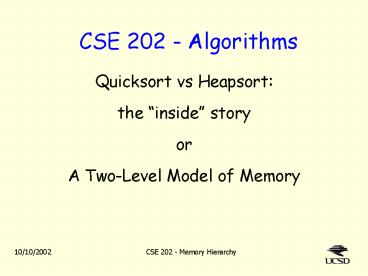CSE 202 - Algorithms PowerPoint PPT Presentation
Title: CSE 202 - Algorithms
1
CSE 202 - Algorithms
- Quicksort vs Heapsort
- the inside story
- or
- A Two-Level Model of Memory
2
Where are we?
- Traditional (RAM-model) analysis Heapsort is
better - Heapsort worst-case complexity is ?(n lg n)
- Quicksort worst-case complexity is ?(n2).
- average-case complexity should be ignored.
- probabilistic analysis of randomized version is
?(n lg n) - Yet Quicksort is popular.
- Goal a better model of computation.
- It should reflect the real-world costs better.
- Yet should be simple enough to perform asymptotic
analysis.
3
2-level memory hierarchy model (MH2)
- Data moves in blocks from Main Memory to cache.
- A block is b contiguous items.
- It takes time b to move a block into cache.
- Cache can hold only b blocks.
- Least recently used block is evicted.
- Individual items are moved from Cache to CPU.
- Takes 1 unit of time.
- Note - b affects
- block size
- cache capacity (b2)
- transfer time
4
2-level memory hierarchy model (MH2)
- For asymptotic analysis, we want b to grow with n
- b 1/3 or 1/4 are plausible choices.
block (Bytes) cache (Bytes) time (cycles) memory (Bytes)
SRAM/DRAM 26 - 28 213 - 220 25 -27 227 - 230
b n1/4 27 214 27 228
DRAM/disk 212 - 213 226 - 230 215 220 232 236
bn1/3 213 226 213 239
5
A worst-case Heapsort instance
- Each Extract-Max goes all the way to a leaf.
- Visits to each node alternate between left and
right child. - Actually, for any sequence of paths from root to
leaves, one can create example. - Construct starting with 1-node heap
15
14
13
10
9
11
12
1
7
5
3
6
2
4
8
6
MH2 analysis of Heapsort
- Assume b n1/3.
- Similar analysis works for b na, 0ltalt½.
- Effect of LRU replacement
- First n2/3 heap elements will usually be in
cache. - Let h ?lg n? be height of the tree.
- These elements are all in top ?(2/3)h? of tree.
- Remaining elements wont usually be in cache.
- In worst case example, they will never be in
cache when you need them. - (Caution hand waving) In general, an earlier
block of array is more likely to be accessed than
a later one. When we kick out an early block to
bring in a later one, we increase misses later.
7
Cache lines of heap (b8, n511, h9)
- 1
- 3
- 4 5 6 7
6 levels, 8 blocks
8 9 10 11 12 13 14 15
24 25 .... 31
16 17 .... 23
56 ... 63
48 ... 55
32 ... 39
40 ... 47
... 127
...
...
...
...
...
...
64..71
h/3 levels
.
.255
.
.
.
.
.
128..
511
.
.
256
8
MH2 analysis of Heapsort (worst-case)
- Every access below level ?(2/3)h? is a miss.
- Each of the first n/2 Extract-maxs bubbles
down to the leaves. - So it has at least (h/3)-1 misses.
- Each miss takes time b.
- Thus, T(n) gt (n/2) ((h/3)-1) b.
- Recall b n1/3 and h ?lg n?.
- Thus, T(n) is ?(n4/3 lg n).
- And obviously, T(n) is O(n4/3 lg n) .
- Each of c n lg n accesses takes time at most b
n1/3. - (where c is constant from RAM analysis of
Heapsort).
9
Quicksort MH2 complexity
- Accesses in Quicksort are sequential
- Sometimes increasing, sometimes decreasing
- When you bring in a block of b elements, you
access every element. - Not 100, but Ill wave my hands
- We take b time getting block for b accesses
- Thus, time in MH2 model is same as RAM.

